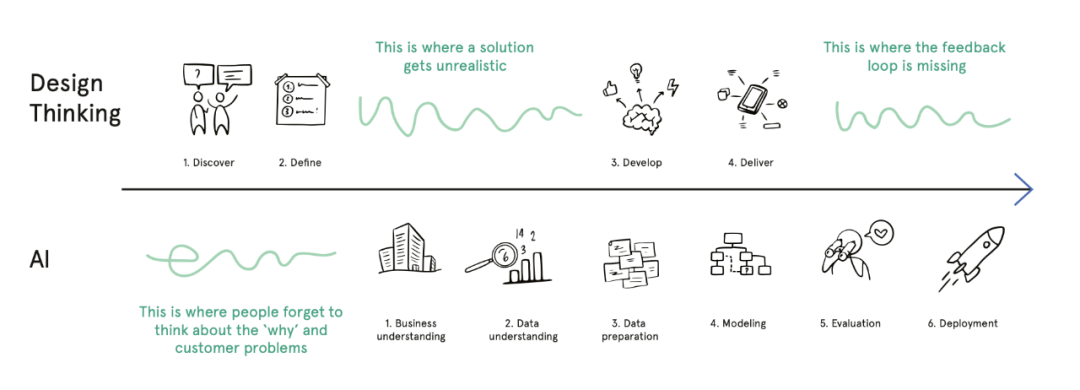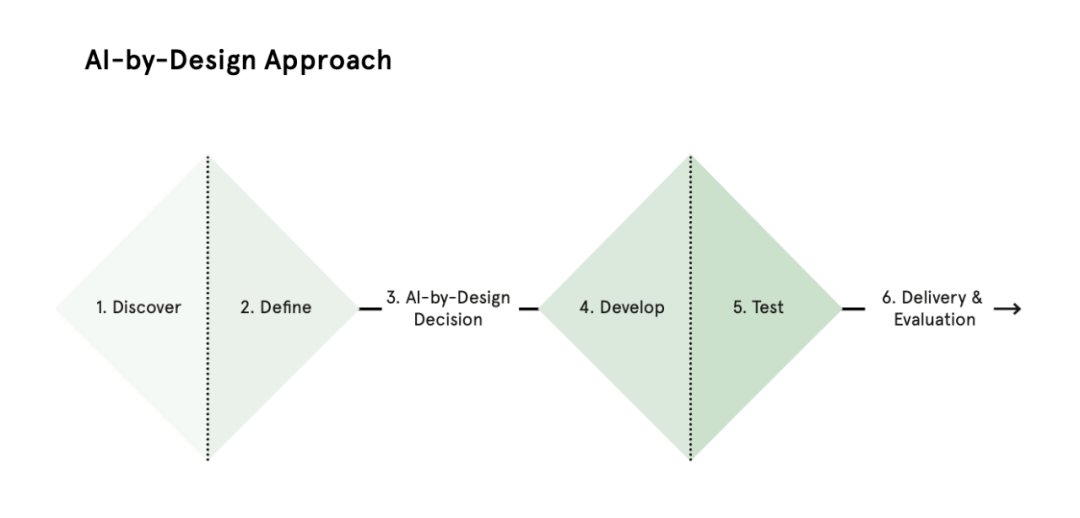 Technology peripherals
Technology peripherals
 AI
AI
 Service design for AI: Building a human-centered approach to AI innovation
Service design for AI: Building a human-centered approach to AI innovation
Service design for AI: Building a human-centered approach to AI innovation
With the development of artificial intelligence, it has gradually been applied in various fields, but in terms of artificial intelligence solutions, designers may face new challenges. This article explores this and proposes a six-step method that integrates the advantages of both disciplines, namely "artificial intelligence design", let's take a look.

Write in front
As AI technology develops, it is becoming increasingly clear that neither technology nor design alone is sufficient to build effective AI solutions, solve real user problems, and have a positive impact on society. AI engineers working without designers may jump to solutions too quickly based on unverified assumptions, causing teams to solve the “wrong problem.” Conversely, a lack of technical knowledge may lead designers to have unrealistic or vague ideas about the capabilities of artificial intelligence, leading to situations where they either overestimate or underestimate its capabilities.
When it comes to AI solutions, designers may face new challenges, such as how to design AI systems for transparency, “explainability,” or trustworthiness. Or how to evaluate the impact and outcomes of AI solutions on users and society. Therefore, we believe artificial intelligence (AI) engineers and service designers should collaborate to create solutions that are human-centered, ethical, and have a positive impact. In this article, we propose a six-step approach that integrates the strengths of both disciplines, namely "Design for Artificial Intelligence."

1. Do we need artificial intelligence (AI)?
We view AI design as a human-centered, iterative and collaborative approach to AI innovation. It leverages a designer’s approach to problem solving while considering the dynamic components of AI, applying an engineering approach to AI innovation. The approach is based on the UK Design Council’s Double Diamond1, CRISP-DM2 data management methodology and our experience in AI innovation at OLX Group, one of the world’s fastest growing marketplace and classification platform networks, with over 300 million online Visitors.
Both AI and design teams can benefit from collaboration. We believe this will lead to more efficient ways of working and more customer-focused solutions. that's why:
1. AI innovation adopts a human-centered approach
AI-by-Design takes a human-centered approach to AI innovation to deeply understand customer needs before developing solutions. Sometimes AI isn't the right solution. Sometimes, simpler solutions such as spreadsheets may do the job well and save resources. Therefore, Before development begins, it needs to be determined whether artificial intelligence is indeed the right tool to solve the problem. Teams should build anything that solves problems and empowers humans, rather than prescribing specific tools or technologies.
2. Leverage interdisciplinarity
AI-by-Design encourages a way of working across silos, rather than a cold handover of insights from design research teams to AI engineers. When designers and AI engineers work together, they can cover each other’s blind spots and reduce the room for communication errors. The process will be more efficient and effective, and the solutions will be more customer-centric and technically feasible. This will ensure they address the right challenges, saving the team time. In fact, in McKinsey’s 2021 State of Artificial Intelligence, “the use of design thinking when developing AI tools” was cited as the most important differentiator for high AI performers.
3. AI-by-Design solutions designed for our dynamic world
Artificial intelligence models are often trained in sandbox environments but end up being used in our messy, complex world. Therefore, we believe that AI models require continuous retraining.
In the real world, solutions are affected by how users interact with the end product, while artificial intelligence has many dynamic components. Designing a way to collect user feedback and actual behavioral data is crucial. This input data is needed to improve models and ensure AI solutions work as intended and in an ethical manner.
There’s actually a gap here, and while this sounds ideal, we can’t just put a few AI engineers and designers on a team and expect them to innovate together effortlessly. We often observe that the two disciplines have no common language, hold incorrect assumptions about each other, and work in different ways.
For example, AI engineers work using Visual Studio Code, while designers typically use tools like Miro. Machine learning models need to work as carefully and accurately as possible, while designing prototypes can be very conceptual and speculative. Machine learning metrics evolve around numbers and predictions, while design metrics evolve around human needs and customer experience. The same differences exist when comparing methods, as shown in Figure 2 . In the figure, the design committee's double diamond overlaps with the CRISP-DM data management method. Three gaps appear:

Gap 1: Missing “why”
If AI engineers are excluded from the initial stages of a project, there is a risk that the solution they build deviates from the original customer problem. Understanding customer needs is key.
Gap 2: Lack of technical understanding
Designers, on the other hand, often have unrealistic expectations about the possibilities of artificial intelligence and are not always aware of the latest technological developments. Because designers cannot easily understand engineering components, they often need help grasping the feasibility of proposed solutions to avoid leaning toward solutions that are difficult to implement.
Gap 3: Lack of feedback loop
At the end of the process, when building the solution, there needs to be a way to check that the solution worked as expected, that the correct data was collected, and that the model was ethical. This can be solved through feedback loops. Feedback loops can provide a lot of visibility and transparency into the solution. This is important because in most cases, the real world is very different from the training environment in which AI is developed. Additionally, new data will be available due to the ongoing interaction between users and developed AI solutions. When the right data is collected, the model can be continuously improved by eliminating biases and outliers.
2. Six steps of AI-by Design
To fill in the gaps and find ways to work, we created a six-step approach.

1.Discovery: The first step is to understand the goals of the project, customer needs and their problems and business opportunities. It usually involves customer research.
2. Definition: In the second step, the team defines the scope of the challenge: they choose the problem to solve or the opportunity to pursue. This step includes researching the background and possibilities of artificial intelligence.
3.AI Design Decisions: At this stage, the team is encouraged to ask themselves whether this is a problem that can and should be solved. This can be solved using AI. If so, they evaluate what data is needed and examine whether the solution might have unethical consequences. This is also a good outcome if AI is not the right solution. Artificial intelligence is expensive and time-consuming. If other alternatives can solve the problem, they should be selected.
4. Development: The fourth step is to understand how best to solve the problem. Now is the time to explore different solutions and look into the data and modeling required. AI engineers can perform exploratory data analysis (EDA), which means digging into the data to better understand it and see if there are outliers, missing values, and if a baseline model can be built.
5. Testing: Before committing to building and deploying a solution, teams should identify what risky assumptions there are and try to validate them, such as using prototype testing. This is the fastest way to check if the solution should be built or if a "pivot" is required.
6.Delivery and Evaluation: Finally, the team should iterate, refine, pitch, and ultimately deliver the solution to the end customer and key stakeholders. However, the process does not end there. Instead, teams need to continually iterate on solutions. Over time, more data will become available that can shed new light on solutions. A monitoring system (feedback loop) needs to be designed to ensure that real-life biases and data drifts are checked and corrected as quickly as possible.
The previous six steps are intended to provide guidance for those who want to improve the way their teams implement AI innovation.
in conclusion
Companies need technology and design to build AI that: (A) is effective, (B) solves real user problems, and (C) has a positive business impact. There is still a long road ahead, but we believe the approach we propose can enable organizations to innovate in an efficient and ethical way.
Original author: Serena Westra, Ioannis Zempekakis (this article has been authorized by the relevant parties and the original author)
Original title: AI-by-Design: Human-Centred AI Innovation: A six-step approach for building AI solutions
Translator: Chen Yuzhi Yeutz Chen, WeChat public account: YeutzDesign (ID: Yeutzsheji), focuses on the field of service design and is committed to research on innovation and transformation of service design.
This article was translated and published by @陈昱志Yeutz Chen on Everyone is a product manager. Reprinting without permission is prohibited.
The title picture comes from Unsplash, based on the CC0 agreement.
The above is the detailed content of Service design for AI: Building a human-centered approach to AI innovation. For more information, please follow other related articles on the PHP Chinese website!

Hot AI Tools

Undresser.AI Undress
AI-powered app for creating realistic nude photos

AI Clothes Remover
Online AI tool for removing clothes from photos.

Undress AI Tool
Undress images for free

Clothoff.io
AI clothes remover

AI Hentai Generator
Generate AI Hentai for free.

Hot Article

Hot Tools

Notepad++7.3.1
Easy-to-use and free code editor

SublimeText3 Chinese version
Chinese version, very easy to use

Zend Studio 13.0.1
Powerful PHP integrated development environment

Dreamweaver CS6
Visual web development tools

SublimeText3 Mac version
God-level code editing software (SublimeText3)

Hot Topics
 1385
1385
 52
52
 I Tried Vibe Coding with Cursor AI and It's Amazing!
Mar 20, 2025 pm 03:34 PM
I Tried Vibe Coding with Cursor AI and It's Amazing!
Mar 20, 2025 pm 03:34 PM
Vibe coding is reshaping the world of software development by letting us create applications using natural language instead of endless lines of code. Inspired by visionaries like Andrej Karpathy, this innovative approach lets dev
 Top 5 GenAI Launches of February 2025: GPT-4.5, Grok-3 & More!
Mar 22, 2025 am 10:58 AM
Top 5 GenAI Launches of February 2025: GPT-4.5, Grok-3 & More!
Mar 22, 2025 am 10:58 AM
February 2025 has been yet another game-changing month for generative AI, bringing us some of the most anticipated model upgrades and groundbreaking new features. From xAI’s Grok 3 and Anthropic’s Claude 3.7 Sonnet, to OpenAI’s G
 How to Use YOLO v12 for Object Detection?
Mar 22, 2025 am 11:07 AM
How to Use YOLO v12 for Object Detection?
Mar 22, 2025 am 11:07 AM
YOLO (You Only Look Once) has been a leading real-time object detection framework, with each iteration improving upon the previous versions. The latest version YOLO v12 introduces advancements that significantly enhance accuracy
 Best AI Art Generators (Free & Paid) for Creative Projects
Apr 02, 2025 pm 06:10 PM
Best AI Art Generators (Free & Paid) for Creative Projects
Apr 02, 2025 pm 06:10 PM
The article reviews top AI art generators, discussing their features, suitability for creative projects, and value. It highlights Midjourney as the best value for professionals and recommends DALL-E 2 for high-quality, customizable art.
 Is ChatGPT 4 O available?
Mar 28, 2025 pm 05:29 PM
Is ChatGPT 4 O available?
Mar 28, 2025 pm 05:29 PM
ChatGPT 4 is currently available and widely used, demonstrating significant improvements in understanding context and generating coherent responses compared to its predecessors like ChatGPT 3.5. Future developments may include more personalized interactions and real-time data processing capabilities, further enhancing its potential for various applications.
 Best AI Chatbots Compared (ChatGPT, Gemini, Claude & More)
Apr 02, 2025 pm 06:09 PM
Best AI Chatbots Compared (ChatGPT, Gemini, Claude & More)
Apr 02, 2025 pm 06:09 PM
The article compares top AI chatbots like ChatGPT, Gemini, and Claude, focusing on their unique features, customization options, and performance in natural language processing and reliability.
 How to Use Mistral OCR for Your Next RAG Model
Mar 21, 2025 am 11:11 AM
How to Use Mistral OCR for Your Next RAG Model
Mar 21, 2025 am 11:11 AM
Mistral OCR: Revolutionizing Retrieval-Augmented Generation with Multimodal Document Understanding Retrieval-Augmented Generation (RAG) systems have significantly advanced AI capabilities, enabling access to vast data stores for more informed respons
 Top AI Writing Assistants to Boost Your Content Creation
Apr 02, 2025 pm 06:11 PM
Top AI Writing Assistants to Boost Your Content Creation
Apr 02, 2025 pm 06:11 PM
The article discusses top AI writing assistants like Grammarly, Jasper, Copy.ai, Writesonic, and Rytr, focusing on their unique features for content creation. It argues that Jasper excels in SEO optimization, while AI tools help maintain tone consist



